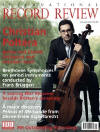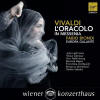Texte paru dans: / Appeared in:
*

International Record Review -
Pour
s'abonner / Subscription information
Virgin
6025472

5099960254726 (ID245)
Consultez toutes les évaluations recensées pour ce cd
~~~~ Reach all the evaluations located for this CD
Although there seem to have been a lot of them in these pages recently, only a tiny fraction of the operas which once adorned the Baroque stage have made it unscathed to the twenty-first century . Late-Baroque operas were seldom published, though some volumes of highlights might be issued if you were Handel. Everyone understood that this ‘exotic and irrational entertainment’ was an essentially ephemeral genre. There was little point in preserving the scores of operas whose shelf life was a few months at the most. Audiences were viciously fickle: their tastes changed on an almost weekly basis and ‘novelty, novelty, novelty’ was the constant cry of singers and listeners alike.
Pity the poor composer. Having laboriously written out the music for a three-hour entertainment with nib-crushing speed and enthusiasm, a few months later he had to start all over again. Or did he? Well not if he was Vivaldi. Vivaldi — like Handel — was a pragmatist: as much a businessman as a musician. If effort could be spared without compromising profits then why not recycle earlier music and, while you were at it, you might even help yourself to music by others as well.
In the detailed booklet notes by the conductor Fabio Biondi and scholar Frédéric Delaméa which accompany this release, we learn that L’oracolo in Messenia was premiered in Venice in December 1737 (to ‘tumultuous applause’) and revived (with the composer’s final revisions) in Vienna in I742 . Phew — at least one score must survive then. No — neither score exists. The librettos are the sole survivors of this operatic venture and they preserve a vital ingredient: the texts of arias from several of Vivaldi’s earlier operas, plus lots of arias from Geminiano Giacomelli‘s Merope (1734), an opera based on much the same libretto used by Vivaldi.
It’s clear, then, that Vivaldi’s L’oracolo was a pasticcio — that curious operatic species in which ‘favourite arias’ were plundered from earlier operas and stitched together with new recitative. If the original scores of Pasticci are missing it should be possible to make a reasonable stab at reconstructing them if the operas on which they drew still survive, at least this is what Biondi argues. But his fairly brief summary of his reconstructive surgery for L’oracolo is a little thin on details: yes, Giacomelli’s Merope has been preserved — so he can draw on it for this reconstruction (of the Vienna version of L’oracolo) — but it’s not clear how and why he’s selected particular arias. As for the recitatives, the case is clear: since Vivaldi’s are all lost, Giacomelli’s recitatives from Merope provide an ideal substitute.
Biondi helpfully tabulates the sources of all the arias — and it’s very revealing. There are a couple of speculative inclusions by Broschi and Hasse, ten numbers by Vivaldi and 13 by Giacomelli. Since Giacomelli (c. 1691-1740) can lay claim to most of the recitative and over half the arias, Biondi is rather cheeky to hill this as a Vivaldi opera; though no more cheeky, I suppose, than Vivaldi himself, whose name alone appears on the original published librettos . Time and again I returned to the aria table to check whose music I was actually listening to, and usually I found I was enjoying Giacomelli’s the most. I can see that Vivaldi’s is the glitzier name on which to hang this project, but a lot less speculation and trouble would have been involved if Biondi had simply had the courage to revive Giacomelli’s Merope lock, stock and barrel, an honour it clearly deserves.
The plot of Vivaldi’s L’oracolo is complex and rather vicious, but three major players dominate the stage: the wronged Queen Merope of Messenia, whose husband and children were murdered on the orders of the pulsatingly evil Polifonte, who has usurped the throne. Happily one of Merope’s children — the plucky young Epitide — still lives (in secret) and returns to court in disguise to sort them all out and fulfil the prophecy of the oracle of Messenia. Vocally, mezzos Vivica Genaux (Epitide) and Ann Hallenberg ( Merope) dominate the performance; Polifonte is sourly sung by tenor Magnus Staveland, and I do mean sourly — there’s a flat-wards inclination to his pitch which I find quite distracting.
Arguably Genaux’s sophisticated mezzo is too ripe a fruit to convey the impetuous, innocence-tinged youthfulness of Epitide, but her dazzling technique and vast lung capacity moulds him into a real young hero. In the Act 3 ‘ Sposa . . . non mi conosci’, with its wildly veering outbursts from the orchestra and imploring melodic line, Biondi and Genaux exactly capture Epitide’s incomprehension at being rejected by both his mother, Merope, and beloved Elmira. This is a real warhorse of an aria (by Giacomelli) — one of the greatest of the age — but here it is really made to serve the drama.
This reverence for dramatic context characterizes the performance as a whole. Hallenberg is always a little on edge dramatically throughout but positively spine-tinglingly wretched in her long solo scene at the end of the final act: a vast accompanied recitative followed by the aria ‘Là sul torbido’, carried along by nervy scratching strings as she contemplates the possibility that her son Epitide is really dead. Staveland doesn’t even have the manners to wait for her final notes to die away before his rude recitative threatens her. Though Staveland can animate a recitative with bags of evil menace, he can’t hold a pure and steady note, and some of his arias fail to live up to their promise.
The other singers acquit themselves convincingly and most of them have at least one coloratura scene stealer in their parts — one of the advantages of all the highlights that went to make up a pasticcio. Mezzo Franziska Gottwald (Licisco) exhibits tremendous virtuosity very low in her register in ‘Neli’orror’ (by Hasse), ably assisted by two spitting horns and some wicked harpsichord improvisation. Soprano Julia Lezhneva (Trasimede) is utterly entrancing in one of the great ‘shipwreck’ simile arias of the time — ‘Son quai nave’ (by Riccardo Broschi). All is fast, furious, pin-point coloratura, even in the vertiginously virtuoso da capo — brought off with such technical assurance that even Health and Safety fundamentalists would have no cause for concern.
The recording itself is excellent: live, but the best of
three separate performances. The result is impressive dramatic immediacy,
considerable technical exactitude and a delicious sense of the singers
engaging with the audience and sometimes really playing to it. A warm
welcome . . . though not to the wicked Polifonte. There’s plenty of really
first-rate music here and more of Giacomelli’s Merope than anything
distinctively Vivaldian — but that’s no criticism at all .
Fermer la fenêtre/Close window
Cliquez l'un ou l'autre
bouton pour découvrir bien d'autres critiques de CD
Click either button for many other reviews


